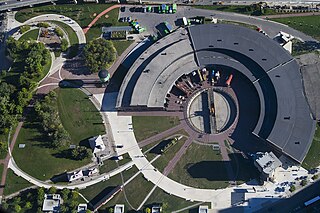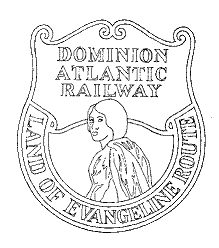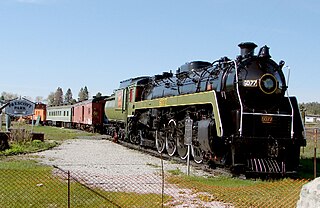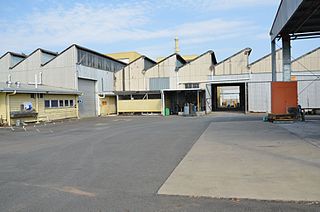Related Research Articles

The Canadian Pacific Railway, also known simply as CPR or Canadian Pacific and formerly as CP Rail (1968–1996), is a Canadian Class I railway incorporated in 1881. The railway is owned by Canadian Pacific Railway Limited, which began operations as legal owner in a corporate restructuring in 2001.
Rail transport operations are the day-to-day operations of a railway. A railway has two major components: the infrastructure and the rolling stock

A railway roundhouse is a building with a circular or semicircular shape used by railways for servicing and storing locomotives. Traditionally, though not always the case today, these buildings surrounded or were adjacent to a turntable.

The St. Lawrence and Atlantic Railroad, known as St-Laurent et Atlantique Quebec in Canada, is a short-line railway operating between Portland, Maine, on the Atlantic Ocean, and Montreal, Quebec, on the St. Lawrence River. It crosses the Canada–US border at Norton, Vermont, and Stanhope, Quebec, and is owned by short-line operator Genesee & Wyoming.

The Dominion Atlantic Railway was a historic railway which operated in the western part of Nova Scotia in Canada, primarily through an agricultural district known as the Annapolis Valley.

The motive power depot (MPD) or locomotive depot, or traction maintenance depot (TMD), is the place where locomotives are usually housed, repaired and maintained when not being used. They were originally known as "running sheds", "engine sheds" or, for short, just sheds. Facilities are provided for refuelling and replenishing water, lubricating oil and grease and, for steam engines, disposal of the ash. There are often workshops for day to day repairs and maintenance, although locomotive building and major overhauls are usually carried out in the locomotive works.

Gateshead TMD was a railway traction maintenance depot situated in Gateshead, England. The depot code was 52A during the steam era and GD later on.

Although most railways of central and eastern Canada were initially built to a 5 ft 6 in broad gauge, there were several, especially in Atlantic Canada and Ontario, which were built as individual narrow-gauge lines. These were generally less expensive to build, but were more vulnerable to frost heaving because vertical displacement of one rail caused greater angular deflection of the narrower two-rail running surface. Most of the longer examples were regauged starting in the 1880s as the railway network began to be bought up by larger companies.

The Valley Heights Rail Museum is a railway museum located in Valley Heights, New South Wales, Australia. The facility is located 300 metres (980 ft) north-west of Valley Heights railway station. The museum is operated by two partner organisations:

Roundhouse Park is a 17 acre park in the downtown core of Toronto, Ontario, Canada. It is in the former Railway Lands. It features the John Street Roundhouse, a preserved locomotive roundhouse which is home to the Toronto Railway Museum, Steam Whistle Brewing, and the restaurant and entertainment complex The Rec Room. The park is also home to a collection of trains, the former Canadian Pacific Railway Don Station, and the Roundhouse Park Miniature Railway. The park is bounded by Bremner Boulevard, Lower Simcoe Street, Lake Shore Boulevard West/Gardiner Expressway and Rees Street.

A Bahnbetriebswerk is a German railway depot where the maintenance of locomotives and other rolling stock is carried out. It is roughly equivalent to a locomotive shed, running shed or motive power depot. These were of great importance during the steam locomotive era to ensure the smooth running of locomotive-hauled services. Bahnbetriebswerke had a large number of facilities in order to be able to carry out their various maintenance tasks. As a result, they needed a lot of staff and were often the largest employers in the area.

Junee railway station is a heritage-listed railway station located on the Main South line in New South Wales, Australia. It serves the town of Junee in the Junee Shire. It was added to the New South Wales State Heritage Register on 2 April 1999.

Canadian National Railways U-1-f class locomotives were a class of twenty 4-8-2 or Mountain type locomotives built by Montreal Locomotive Works in 1944. They were numbered 6060–6079 by CN and nicknamed "Bullet Nose Bettys" due to their distinctive cone-shape smokebox door cover.
The Palmerston Railway Heritage Museum is the only original station left in Wellington County, Ontario and one of the few designated as a railway museum in its part of the province. The Palmerston Station is located at 166 William Street, Palmerston, Ontario.
There were a number of engine sheds and railway works located in York. The large York North engine shed became the National Railway Museum in 1975.
The Algoma Eastern Railway was a railway in Northeastern Ontario, Canada. Originally known as the Manitoulin and North Shore Railway (M&NS) with a charter dating back to 1888, the full mainline was opened to traffic in 1913, serving the area along the north shore of Lake Huron between Sudbury and Little Current on Manitoulin Island. It and its sister railway, the Algoma Central, were originally owned by the Lake Superior Corporation, a conglomerate centred on Sault Ste. Marie which was founded by the American industrialist Francis Clergue. Despite ambitious plans to expand across Lake Huron to the Bruce Peninsula using a railcar ferry, the company failed to develop further and was acquired by the Canadian Pacific Railway in 1930. With freight traffic low during the Great Depression, Canadian Pacific soon abandoned much of the Algoma Eastern mainline in favour of its own Algoma Branch. Remaining sections of the Algoma Eastern line were turned into spurs, with the longest surviving section operated as a branch line known as the Little Current Subdivision.

Memmingen station in the city of Memmingen in the German state of Bavaria. The current station building had two predecessors, with the original being opened in 1862. The Buchloe–Memmingen and the Leutkirch–Memmingen railways meet the Neu-Ulm–Kempten railway in Memmingen. The route from Munich to Zurich through Memmingen station is planned to be upgraded for tilting trains and electrified.

Broadmeadow Locomotive Depot was a large locomotive depot consisting of two roundhouse buildings and associated facilities constructed by the New South Wales Government Railways adjacent to the marshalling yard on the Main Northern line at Broadmeadow. Construction of the locomotive depot at Broadmeadow commenced in 1923 to replace the existing crowded loco sheds at Woodville Junction at Hamilton, with the depot opening in March 1924. It was added to the New South Wales State Heritage Register on 2 April 1999.

Stewarts Lane is a large railway-servicing facility in Battersea in London, England, founded by the London Chatham and Dover Railway (LCDR) in 1862, to serve London Victoria railway station. It is sited in the midst of a maze of railway lines between 'Factory Junction' and 'Stewarts Lane Junction', adjacent to the site of the former Longhedge Railway Works and the Stewarts Lane Chord formerly used by Eurostar trains from the Kent freight lines to Waterloo International station. Prior to 1962 it was one of the largest motive power depots in the UK. Following the end of steam traction in the early 1960s it was converted into a traction maintenance depot which is currently operated by Govia Thameslink Railway.

Rockhampton Railway Workshops is a heritage-listed railway workshop at 380 Bolsover Street, Depot Hill, Rockhampton Region, Queensland, Australia. It was built from 1915 to 1953. It is also known as Rockhampton Roundhouse. It was added to the Queensland Heritage Register on 21 August 1992.
References
- 1 2 Canadian Northern Railway: 1905 - Alberta Centennial Archived October 10, 2008, at the Wayback Machine
- ↑ "Canadian Railway Hall of Fame - Melville, Saskatchewan". Archived from the original on 2011-07-06. Retrieved 2008-06-12.
- ↑ Northern Ontario Railroad Museum: Capreol & Area Archived December 9, 2008, at the Wayback Machine